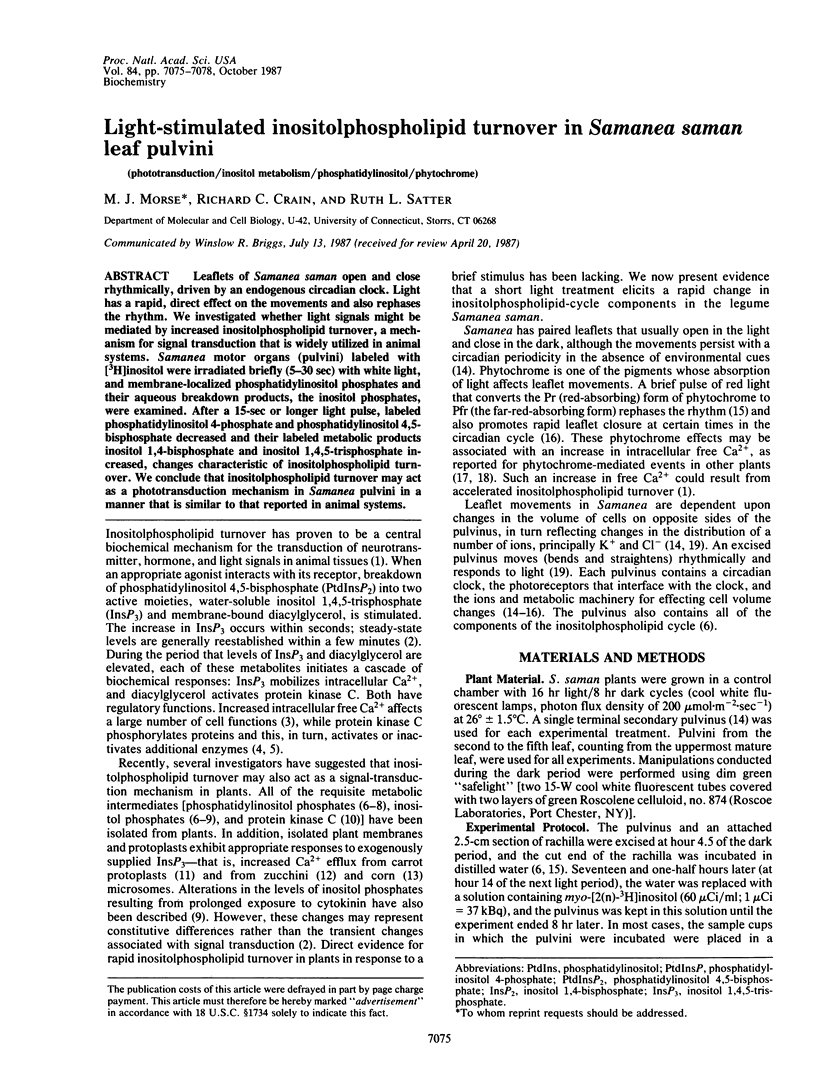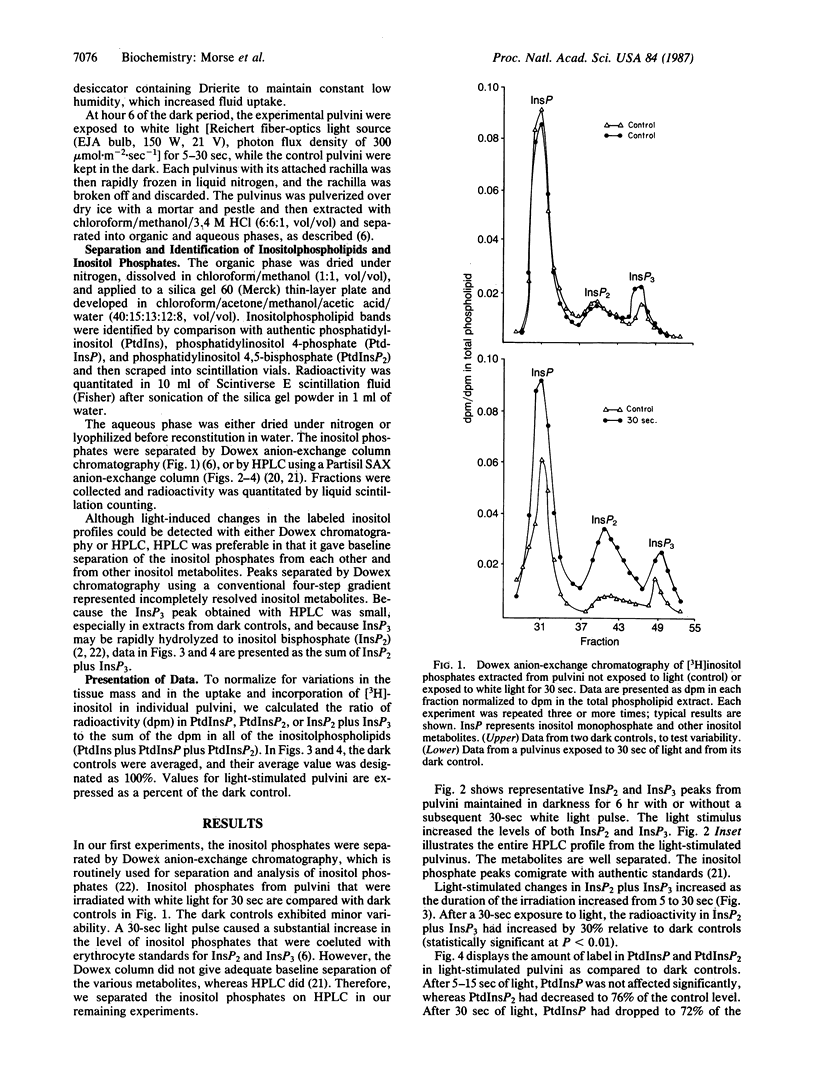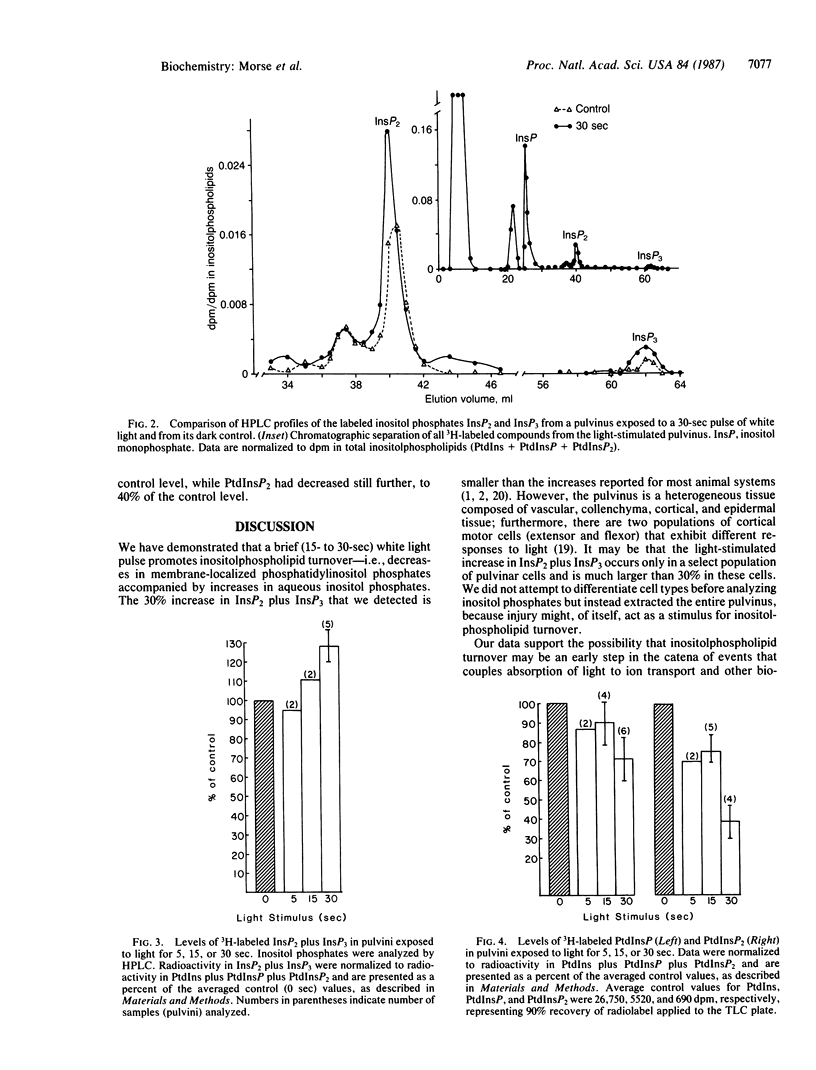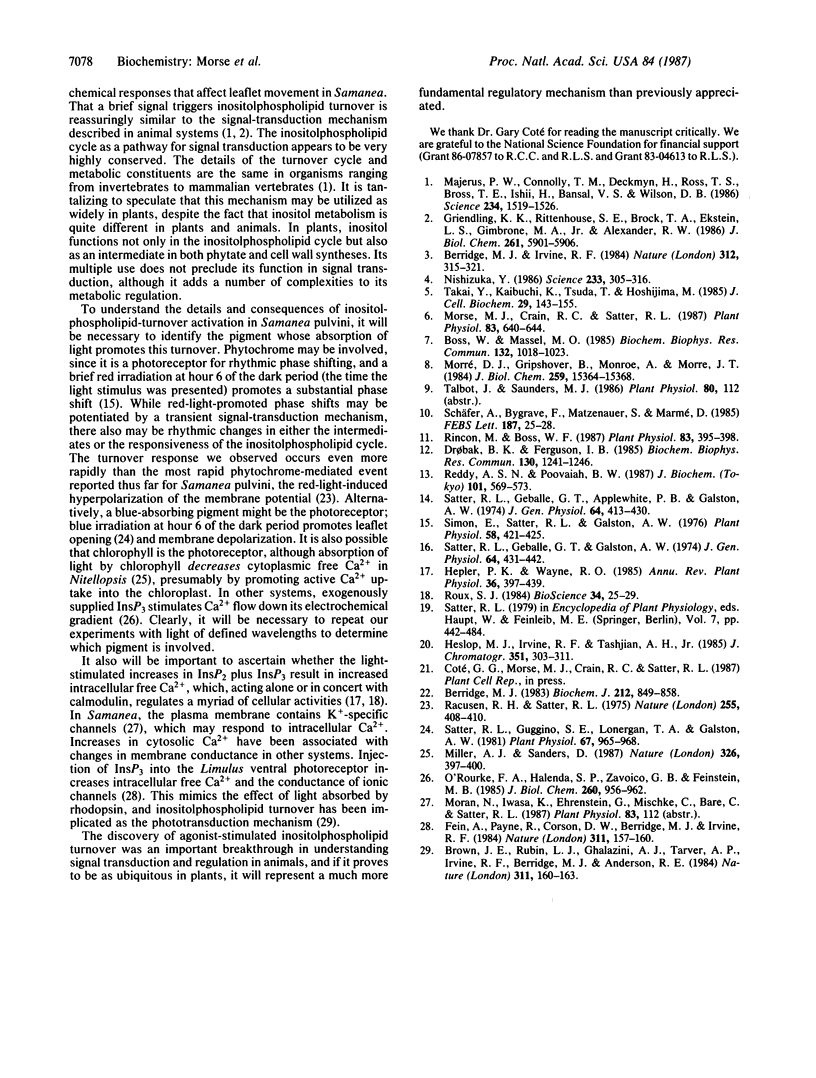Abstract
Leaflets of Samanea saman open and close rhythmically, driven by an endogenous circadian clock. Light has a rapid, direct effect on the movements and also rephases the rhythm. We investigated whether light signals might be mediated by increased inositolphospholipid turnover, a mechanism for signal transduction that is widely utilized in animal systems. Samanea motor organs (pulvini) labeled with [3H]inositol were irradiated briefly (5-30 sec) with white light, and membrane-localized phosphatidylinositol phosphates and their aqueous breakdown products, the inositol phosphates, were examined. After a 15-sec or longer light pulse, labeled phosphatidylinositol 4-phosphate and phosphatidylinositol 4,5-bisphosphate decreased and their labeled metabolic products inositol 1,4-bisphosphate and inositol 1,4,5-trisphosphate increased, changes characteristic of inositolphospholipid turnover. We conclude that inositolphospholipid turnover may act as a phototransduction mechanism in Samanea pulvini in a manner that is similar to that reported in animal systems.
Keywords: phototransduction, inositol metabolism, phosphatidylinositol, phytochrome
Full text
PDF



Selected References
These references are in PubMed. This may not be the complete list of references from this article.
- Berridge M. J., Irvine R. F. Inositol trisphosphate, a novel second messenger in cellular signal transduction. Nature. 1984 Nov 22;312(5992):315–321. doi: 10.1038/312315a0. [DOI] [PubMed] [Google Scholar]
- Berridge M. J. Rapid accumulation of inositol trisphosphate reveals that agonists hydrolyse polyphosphoinositides instead of phosphatidylinositol. Biochem J. 1983 Jun 15;212(3):849–858. doi: 10.1042/bj2120849. [DOI] [PMC free article] [PubMed] [Google Scholar]
- Boss W. F., Massel M. O. Polyphosphoinositides are present in plant tissue culture cells. Biochem Biophys Res Commun. 1985 Nov 15;132(3):1018–1023. doi: 10.1016/0006-291x(85)91908-4. [DOI] [PubMed] [Google Scholar]
- Brown J. E., Rubin L. J., Ghalayini A. J., Tarver A. P., Irvine R. F., Berridge M. J., Anderson R. E. myo-Inositol polyphosphate may be a messenger for visual excitation in Limulus photoreceptors. Nature. 1984 Sep 13;311(5982):160–163. doi: 10.1038/311160a0. [DOI] [PubMed] [Google Scholar]
- Drøbak B. K., Ferguson I. B. Release of Ca2+ from plant hypocotyl microsomes by inositol-1,4,5-trisphosphate. Biochem Biophys Res Commun. 1985 Aug 15;130(3):1241–1246. doi: 10.1016/0006-291x(85)91747-4. [DOI] [PubMed] [Google Scholar]
- Fein A., Payne R., Corson D. W., Berridge M. J., Irvine R. F. Photoreceptor excitation and adaptation by inositol 1,4,5-trisphosphate. Nature. 1984 Sep 13;311(5982):157–160. doi: 10.1038/311157a0. [DOI] [PubMed] [Google Scholar]
- Griendling K. K., Rittenhouse S. E., Brock T. A., Ekstein L. S., Gimbrone M. A., Jr, Alexander R. W. Sustained diacylglycerol formation from inositol phospholipids in angiotensin II-stimulated vascular smooth muscle cells. J Biol Chem. 1986 May 5;261(13):5901–5906. [PubMed] [Google Scholar]
- Majerus P. W., Connolly T. M., Deckmyn H., Ross T. S., Bross T. E., Ishii H., Bansal V. S., Wilson D. B. The metabolism of phosphoinositide-derived messenger molecules. Science. 1986 Dec 19;234(4783):1519–1526. doi: 10.1126/science.3024320. [DOI] [PubMed] [Google Scholar]
- Morré D. J., Gripshover B., Monroe A., Morré J. T. Phosphatidylinositol turnover in isolated soybean membranes stimulated by the synthetic growth hormone 2,4-dichlorophenoxyacetic acid. J Biol Chem. 1984 Dec 25;259(24):15364–15368. [PubMed] [Google Scholar]
- Morse M. J., Crain R. C., Satter R. L. Phosphatidylinositol Cycle Metabolites in Samanea saman Pulvini. Plant Physiol. 1987 Mar;83(3):640–644. doi: 10.1104/pp.83.3.640. [DOI] [PMC free article] [PubMed] [Google Scholar]
- Nishizuka Y. Studies and perspectives of protein kinase C. Science. 1986 Jul 18;233(4761):305–312. doi: 10.1126/science.3014651. [DOI] [PubMed] [Google Scholar]
- O'Rourke F. A., Halenda S. P., Zavoico G. B., Feinstein M. B. Inositol 1,4,5-trisphosphate releases Ca2+ from a Ca2+-transporting membrane vesicle fraction derived from human platelets. J Biol Chem. 1985 Jan 25;260(2):956–962. [PubMed] [Google Scholar]
- Racusen R., Satter R. L. Rhythmic and phytochrome-regulated changes in transmembrane potential in samanea pulvini. Nature. 1975 May 29;255(5507):408–410. doi: 10.1038/255408a0. [DOI] [PubMed] [Google Scholar]
- Reddy A. S., Poovaiah B. W. Inositol 1,4,5-trisphosphate induced calcium release from corn coleoptile microsomes. J Biochem. 1987 Mar;101(3):569–573. doi: 10.1093/jb/101.3.569. [DOI] [PubMed] [Google Scholar]
- Rincon M., Boss W. F. myo-Inositol Trisphosphate Mobilizes Calcium from Fusogenic Carrot (Daucus carota L.) Protoplasts. Plant Physiol. 1987 Feb;83(2):395–398. doi: 10.1104/pp.83.2.395. [DOI] [PMC free article] [PubMed] [Google Scholar]
- Roux S. J. Ca2+ and phytochrome action in plants. Bioscience. 1984 Jan;34(1):25–29. [PubMed] [Google Scholar]
- Satter R. L., Geballe G. T., Applewhite P. B., Galston A. W. Potassium flux and leaf movement in Samanea saman. I. Rhythmic movement. J Gen Physiol. 1974 Oct;64(4):413–430. doi: 10.1085/jgp.64.4.413. [DOI] [PMC free article] [PubMed] [Google Scholar]
- Satter R. L., Geballe G. T., Galston A. W. Potassium flux and leaf movement in Samanea saman. II. Phytochrome controlled movement. J Gen Physiol. 1974 Oct;64(4):431–442. doi: 10.1085/jgp.64.4.431. [DOI] [PMC free article] [PubMed] [Google Scholar]
- Satter R. L., Guggino S. E., Lonergan T. A., Galston A. W. The effects of blue and far red light on rhythmic leaflet movements in samanea and albizzia. Plant Physiol. 1981 May;67(5):965–968. doi: 10.1104/pp.67.5.965. [DOI] [PMC free article] [PubMed] [Google Scholar]
- Simon E., Satter R. L., Galston A. W. Circadian Rhythmicity in Excised Samanea Pulvini: II. Resetting the Clock by Phytochrome Conversion. Plant Physiol. 1976 Sep;58(3):421–425. doi: 10.1104/pp.58.3.421. [DOI] [PMC free article] [PubMed] [Google Scholar]
- Takai Y., Kaibuchi K., Tsuda T., Hoshijima M. Role of protein kinase C in transmembrane signaling. J Cell Biochem. 1985;29(2):143–155. doi: 10.1002/jcb.240290209. [DOI] [PubMed] [Google Scholar]


